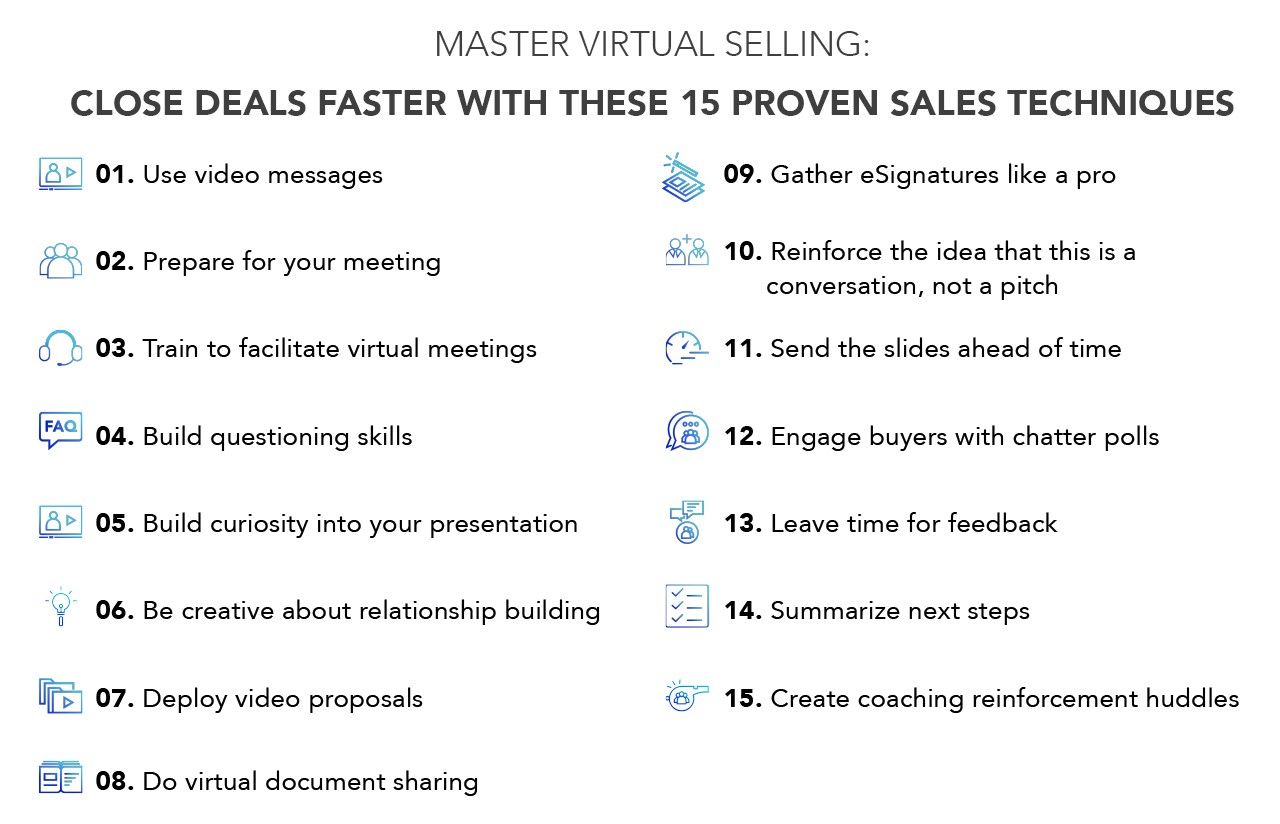The pandemic made 2020 an especially difficult year for sales teams, and with little progress made towards returning back to the offices, it looks like virtual selling is here for the long-run.
While conducting remote sales required necessary operational and structural adjustments to companies’ workflows, the pandemic has actually dramatically changed sales strategies for the better.
Virtual selling allows a sales organization to increase efficiency when working with customers because traveling for every face-to-face sales meeting is no longer the expectation. The efficiency that sales teams have when it comes to working with buyers is heightened, focusing on deepening understanding. As a result, the pandemic has allowed teams to compress and shorten the sales cycle, which is a huge opportunity for companies everywhere.

- How ready are my sales teams to embrace this new way of selling virtually?
- How ready are my sales coaches and how ready are my managers?
It is proven that companies who embraced virtual selling and successfully digitized their sales processes have enabled their teams to sell virtually, trained managers to reinforce these new practices, and engage with buyers in a new virtual way. These companies are seeing shorter sales cycles, which means closing deals faster and not only hitting but exceeding, their sales quotas.
The new culture of virtual sales calls digitizes both the buyer journey and the company’s sales process, compressing and shortening sales cycles to the benefit of all stakeholders. By incorporating the following tips and working with your sales team to develop a robust virtual sales strategy, your sales organization will be able to:
- Improve and up-level your current sales training;
- Reinforce the new sales processes with managed coaching; and
- Embrace virtual selling and incorporate it into your sales enablement practice
Adjusting to this new model to sell virtually only requires a few adjustments to produce dynamic virtual sales professionals. This SalesHood Remote Selling Mastery Guide below provides expert virtual sales tips to help companies uplevel their sales processes.
Does remote selling work?

Remote selling, like cold calling, is an art that harbors many skeptics. To be sure, there are challenges, but when sales professionals embrace and lean into virtual selling and take the time to get it right, they see results in purchase decisions. Sales opportunities still abound online. In a quick SalesHood sampling of some growth companies that have embraced virtual selling, what jumps out in these earnings calls is how quickly companies see customer results.
What are companies doing to be effective at virtual selling?
There are three main focus areas that sellers are paying attention to in order to level up, even without face to face discussions. Sales companies are leveling up their sales process, leveling up their sales training for sales professionals, and doing more sales coaching to ensure that remote sellers have the tools they need to succeed in doing sales calls and quickly close their deals. One important consideration to note is that because everyone is remote selling during COVID-19, the companies with the best virtual sellers and the best remote selling strategy will stand out.
Applying a virtual selling lens to every step in the sales process is how companies can begin to embrace and lean into remote selling to build better salespeople. Incorporating the remote selling best practices below into your sales process, sales training, and sales coaching will ensure that you can build a resilient organization, improve business development opportunities, and achieve similar growth outcomes.
1. Use video messages
- In the first step, the best sales companies are developing video-based prospecting messages and selling with video
- Quick 30-second clips can add an extra touch when generating leads or boosting your presence on social media
- It can also be used across the sales process in thank you or summary emails
2. Prepare for your meeting
- While companies always used to prep for meetings, now that everything is remote it is more critical to be prepared for your sales presentations and to facilitate a good sales environment
- The extent to which you are prepared will be amplified when you can no longer rely on body language and non-verbal cues. Content is key
- Remember to remind your teams to conduct research and do their due diligence, including researching the teams, reading reports, even checking their social media pages, and connecting with individuals on LinkedIn
- Small details, like setting virtual meeting agendas and including them in the invite will also go a long way in showing the buyers that you are prepared in every step of the selling process
- Having either a neutral background or a professional Zoom virtual background that works is important; make sure your team is technically versed and can navigate getting on and off Zoom
3. Train to facilitate virtual meetings
- Likewise, facilitating a meeting over Zoom is very different from doing it in-person
- A key component of virtual sales is virtual sales training, or building skills specific to doing things online
- Your sales professionals will need extra practice and prep before going into their first virtual sales meeting
- It is also important to remind them that dressing for success is still a part of the equation, even if everyone is working from home
4. Build questioning skills
- Another key skill for teams to build in the diagnosing stage is how to ask good questions
- These early-stage funnel activity is important to test out and may be difficult to do online
5. Build curiosity into your presentation
- Prepare your sales professionals by getting them into the spirit of asking questions
- Because this is a conversation and not a pitch, there has to be information flowing in two directions
- Train them to build transitional questions into the slides so that they are opening up space for the client to speak as well
- This creates space for them to think about how to incorporate this new information into the conversation so the client feels heard
- These are concrete ways for your team to level up the sales process and build skills so that you can win more deals
6. Be creative about relationship building
- When doing business online, small things like sending meeting summaries and meeting notes quickly can make a big difference in ensuring that your virtual selling was effective and memorable
- In addition, just because in-person meetings are no longer an option doesn’t mean that the same gestures sales companies once employed won’t work anymore
- Make sure your sales professionals sends written cards and gifts, online or through snail mail, to stand out from other companies
- Conducting sales virtually doesn’t have to be impersonal, and there are innovative ways to ensure that your copany still stands out
7. Deploy video proposals
- Like video messages in the prospecting phase, well-crafted video proposals can help you stand out
- It also furthers the notion that your company is an expert at virtual sales and have been doing this for quite some time
8. Do virtual document sharing
- Demonstrating competency in navigating working together online starts internally and extends through to the sales meeting
- Internally, is your staff comfortable using Google Docs in their browser or other technology so that you’re digitizing the entire process?
- Building digital competency into your company ensures that every aspect of your sales process is digitized and virtual and there are no unexpected tech challenges
- This reinforces the notion that remote selling is here to stay, and that teams should look to this as a new phase of growth, rather than a temporary phase
9. Gather eSignatures like a pro
- Finally, extend that digital competency toward your prospective leads and gather eSignatures to truly digitize all phase of your process
10. Reinforce the idea that this is a conversation, not a pitch
- It is easy to sit behind a computer and listen, but part of being an effective salesperson is getting people to open up and talk. After all, this is still a face to face conversation–just with a screen between two people
- The one aspect of in-person meetings that virtual sales meetings don’t have is that downtime to have a conversation when going from office lobbies into the meeting room
- Keeping time before and after meetings to get to know your client is the virtual way of replicating that
- Work with your staff to be able to talk to a variety of different people and conduct dry runs before the virtual meeting to practice
11. Send the slides ahead of time
- Sending the presentation ahead of time–and not just five minutes beforehand–achieves two main goals
- Externally, your sales reps will have a richer conversation because they’ll have had time to look at your content and think about what questions to ask you
- Your team will spend less time talking about the presentation and more time on the feedback on the presentation
- Again, the key is to facilitate a conversation and not a pitch
- Internally, this gives your team time to prepare for different questions and to know the presentation back to front instead of scrambling to finish something at the last minute
12. Engage buyers with chatter polls
- A tool that your team can use to facilitate conversation is to use polls built into video conferencing platforms
- Asking easy questions is an easy way to get people comfortable on the call and make it low stakes for people to participate without getting into the weeds of your presentation yet
- During and after your presentation, your team can use polls to engage customers in the content, like selecting priorities so you have a clear understanding of what they’re looking for
- Gathering all this information will expedite the process and help you close those deals
13. Leave time for feedback
- In addition to building in time for conversation, it is equally important for the customer to be able to share feedback
- If you’re aiming for a 60-minute meeting, make sure your sales team leaves a 15-minute window of time in the end for the customer to share their thoughts
- A key aspect of turning meetings into momentum is understanding what your customer is feeling and sentiments about your solution and presentation
- Train your team to give them space, even if it might mean sitting in silence for a couple of seconds. This just means that the customer is collecting their thoughts
14. Summarize next steps
- Be sure your team is trained upon follow-up and email etiquette
- It is important to summarize the next steps to get everyone on the same page on what you agreed on during the meeting
- At the end of the meeting, your sales team should be ready to pop open a document, screen share, and articulate what they learned, accomplished, and discussed
- Then your sales team and the customers can get alignment on the next steps immediately rather than going back and forth over email
15. Create coaching reinforcement huddles
- Build-in times for your sales team to practice what they’ve learned, either with each other or with sales coaches and managers
- The goal of learning how to succeed in virtual selling and achieving those growth outcomes is building strong internal teams and sales leaders that are fully ready with the mentality and mindset of how to close virtual sales
- Enable your sales and customer success teams to close deals faster and improve win-rates with our Remote Selling Mastery Coaching Membership created by Winning By Design.
How Ready Is Your Sales Process For Virtual Selling?
It is critical to have a foundation of excellence when it comes to the sales process, which some may refer to as the sales journey or customers’ journey. In order to build this foundation, it is important to document everything, from the conversations to the coaching and finally to the content.
Is virtual selling here to stay?
The reality of 2020 provided many personal and professional challenges, but there are silver linings that we can look to in 2021. While things may eventually go back to normal and companies restart in-person sales meetings, it is clear that the benefits of selling virtually will ensure that companies continue to pursue remote B2B sales to improve profit margins and streamline processes. Customers are also now expecting to be catered to online, so virtual selling and remote sales efforts are definitely here to stay.
These virtual sales tips will ensure that teams are ready to embrace this new way of remote selling and that sales coaches and managers are prepared to reinforce these ideas in key the sales call.
Applying a virtual selling lens to every step in the sales process is how companies can begin to embrace and lean into remote selling.
By embracing these practices, you and your sales organization will be prepared for 2021, this next phase of sales, and beyond.





